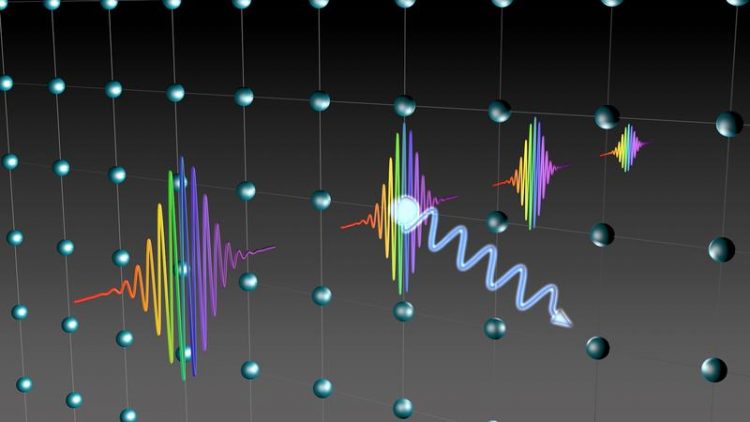Ultrashort and Extremely Precise

Innsbruck physicists observe a surprising quantum effect when short light pulses interact with matter. Patrick Maurer
The invention of the light microscope marks the beginning of modern science; its application has enabled scientists to answer fundamental scientific questions. Microscopes are still an extremely important tool in research and are standard equipment in many laboratories.
Chemistry Nobel laureate Stefan Hell coined the term nanoscopes for describing high-resolution or far-field light microscopes because they also show objects in the nanometer sphere. Together with Ignacio Cirac from the Max-Planck Institute for Quantum Optics in Garching, Oriol Romero-Isart and PhD student Patrick Maurer have now made a discovery that may lead to a completely new scheme for far-field light nanoscopy.
The light’s wavelength poses a limit to the resolution of light microscopes. However, by applying some technical adjustments, scientists are able to circumvent the obstacles and achieve higher resolutions. In a theoretical paper published in the current issue of Physical Review Letters, the physicists in Innsbruck have now demonstrated how a train of attosecond pulses of polychromatic light could be used to excite a two-level system, which is a basic model system in quantum mechanics.
After a short period of time the system returns to its ground state thereby emitting a light particle that can be detected. “Since we can focus attosecond lasers really well, our new approach may lead to the development of a new technology for nanoscopes,” says an excited Romero-Isart, whose research group also studies topics in the field of nano-optics.
“The light pulse spectrum could range from radiofrequencies to ultraviolet light,” explains Maurer. “The resolution will be determined by the mean wave length of the light.” The duration of the light pulse has to be extremely short, that is in the attosecond range – an attosecond is a billionth of a billionth of a second. The next step for the scientists is to calculate their approach with real molecules to pave the way for developing novel nanoscopes.
Publication: Ultrashort Pulses for Far-Field Nanoscopy. Patrick Maurer, J. Ignacio Cirac, and Oriol Romero-Isart. Phys. Rev. Lett. 117, 103602 – Published 29 August 2016
doi: 10.1103/PhysRevLett.117.103602
Rückfragehinweis:
Oriol Romero-Isart
Institut für Quantenoptik und Quanteninformation
Österreichische Akademie der Wissenschaften
phone: +43 512 507 4730
email: oriol.romero-isart@uibk.ac.at
http://dx.doi.org/10.1103/PhysRevLett.117.103602 – Ultrashort Pulses for Far-Field Nanoscopy. Patrick Maurer, J. Ignacio Cirac, and Oriol Romero-Isart. Phys. Rev. Lett. 117, 103602
http://iqoqi.at/en/group-page-romero-isart – Quantum Nanophysics, Optics and Information, IQOQI
Media Contact
More Information:
http://www.uibk.ac.atAll latest news from the category: Physics and Astronomy
This area deals with the fundamental laws and building blocks of nature and how they interact, the properties and the behavior of matter, and research into space and time and their structures.
innovations-report provides in-depth reports and articles on subjects such as astrophysics, laser technologies, nuclear, quantum, particle and solid-state physics, nanotechnologies, planetary research and findings (Mars, Venus) and developments related to the Hubble Telescope.
Newest articles

High-energy-density aqueous battery based on halogen multi-electron transfer
Traditional non-aqueous lithium-ion batteries have a high energy density, but their safety is compromised due to the flammable organic electrolytes they utilize. Aqueous batteries use water as the solvent for…

First-ever combined heart pump and pig kidney transplant
…gives new hope to patient with terminal illness. Surgeons at NYU Langone Health performed the first-ever combined mechanical heart pump and gene-edited pig kidney transplant surgery in a 54-year-old woman…

Biophysics: Testing how well biomarkers work
LMU researchers have developed a method to determine how reliably target proteins can be labeled using super-resolution fluorescence microscopy. Modern microscopy techniques make it possible to examine the inner workings…





















